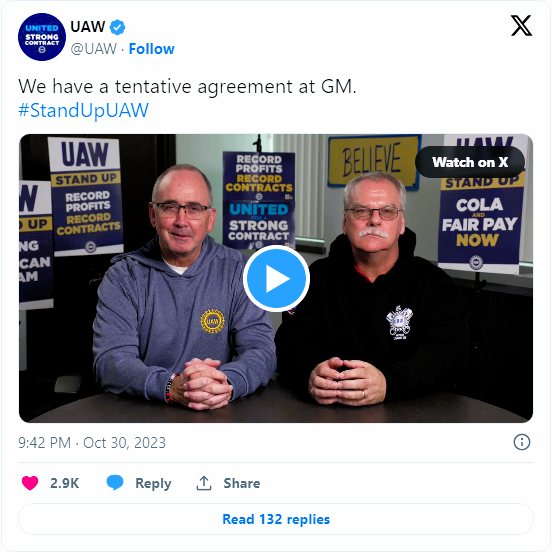GM Reaches Tentative Deal With UAW, Ending Historic Strike
On October 31, 2023, General Motors (GM) and the United Auto Workers (UAW) union reached a tentative agreement, bringing an end to a six-week strike that had upended U.S. automobile production and cost the industry billions of dollars. The strike was the first time in over 50 years that all three of the Detroit automakers had been struck simultaneously.
The tentative agreement, which still must be approved by GM’s 46,000 union members, includes a 25% hourly pay raise plus cost-of-living allowances through April 2028, the removal of several wage tiers, and the inclusion of additional workers in the master agreement, including those at the Ultium Cells venture mato make electric-vehicle batteries.
The terms of the agreement are broadly similar to the deals signed earlier by Ford and Stellantis. However, there are some key differences. For example, the GM agreement includes a higher pay raise (25% versus 18%) and restores a cost-of-living allowance, which was eliminated in the 2009 bankruptcy crisis.
Impact of the Strike
The UAW strike significantly impacted the U.S. economy, costing an estimated $9.3 billion in economic losses. It also disrupted the auto industry supply chain and caused production delays at GM plants.
GM said in its third-quarter earnings report that the strike had a $200 million impact in its first two weeks during the third quarter, and estimated that the strike would have an approximately $200 million-per-week impact. This estimate was made before the union’s final strike expansion on Oct. 28.
Implications for the Auto Industry
The new agreement between GM and the UAW will have several implications for the auto industry. First, the higher wages and cost-of-living allowance will increase labor costs for GM. This could put pressure on the automaker’s margins and profitability.
Second, the agreement could lead to higher prices for new vehicles. GM may pass on some of its increased labor costs to consumers in the form of higher prices.
Third, the agreement could impact GM’s transition to electric vehicles. The automaker has invested heavily in electric vehicle development and production. However, the higher labor costs under the new contract could make it more difficult for GM to compete with foreign automakers in the electric vehicle market.
Analysis
The tentative agreement between GM and the UAW is a positive development for workers and the auto industry as a whole. The agreement provides workers with a significant pay raise and other benefits. It also helps to ensure that the auto industry will continue to be a major driver of the U.S. economy.
However, the agreement also has some potential negative implications. The higher labor costs could put pressure on GM’s margins and profitability, lead to higher prices for new vehicles, and impact the automaker’s transition to electric vehicles.
It is important to note that the tentative agreement is just that: tentative. It still must be approved by GM’s union members. If the agreement is rejected, the strike could resume.
Overall, the tentative agreement between GM and the UAW is a mixed bag. It provides workers with significant benefits, but it could also have some negative implications for the automaker and the auto industry. How GM will manage the higher labor costs under the new contract remains to be seen.
We have a tentative agreement at GM.#StandUpUAW pic.twitter.com/UtaWZJurEW
— UAW (@UAW) October 30, 2023
The UAW strike was a watershed moment for the auto industry. It showed that workers are willing to stand up for their rights and demand a fair share of the profits. The strike also highlighted the challenges facing the auto industry as it transitions to electric vehicles.
The tentative agreement between GM and the UAW is a step in the right direction. It provides workers with a significant pay raise and other benefits. However, it remains to be seen how the agreement will impact GM’s bottom line and its transition to electric vehicles.




One thought on “GM Reaches Tentative Deal With UAW, Ending Historic Strike”